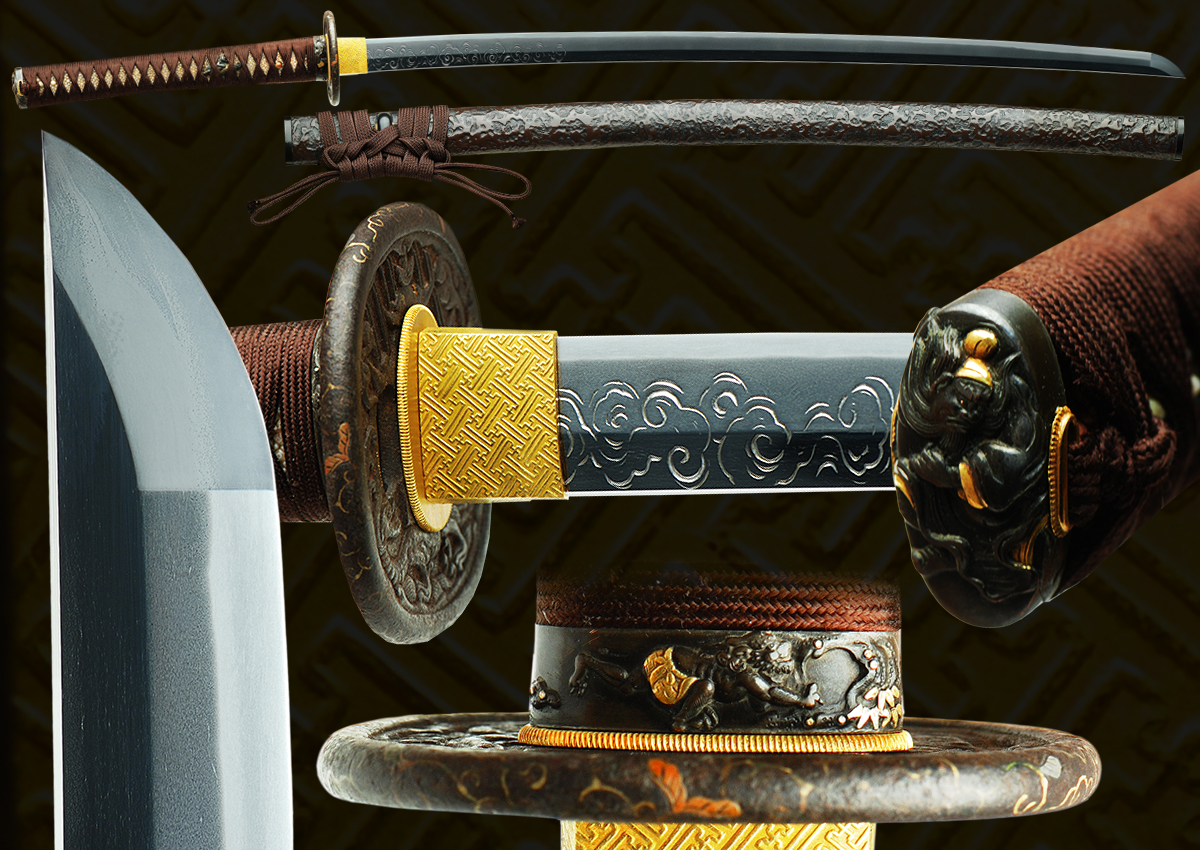YASUKUNI (康国), 1st gen., Kyōroku (享禄, 1528-1532), Sagami – “Sōshū-jū Yasukuni” (相州住康国), “Yasukuni saku” (康国作), Odawara-Sōshū group, according to tradition a student of Shimada Yoshisuke (義助) and the younger brother of Tsunaie (綱家), Hōjō Ujiyasu (北条氏康, 1515-1571) granted him the character for “yasu” (康), the hamon is a gunome-midare or notare-midare with unobtrusive nie, that means the Sōshū tradition with its emphasis on nie already began to disappear at that time, he was an excellent horimono carver, ō-wazamono, jō-saku
This a beautiful later period Koto Katana in the Soshu tradition, this sword is reminiscent of the beautiful work of this era. The blade is a longish mumei piece with a fine hada and a wavy notare-ish sugu-ha hamon. At almost 28” this blade is a wonderful piece with pristine hormono. The hada is a fine Mokume with itame covered in ji-nie which produces an oily slick appearance. There is a longish ko-maru kissaki with hakikake. There is ji-nie all over. The sublime execution of the the ko-itame with mokume reminds one of the twinkling of stars as the ji-nie highlights the intricacies of the workmanship of the steel. The hamon is made up of a conservative wavy sugu-ha base which looks spectacular in this polish which is pristine. A fantastic sword with much to enjoy and appreciate.
The koshirae is a beautiful stand out set. These are of a shoki and oni theme with a golden ken. There is a beautifully textured saya of a darkish lacquer mixed with brown in a larger stone like texture mimicking the cloud like horimono. There is also a gold foil key fret style habaki with gold washed Seppa.
Yasukuni, a JoSaku smith was a master of horimono as can be seen on this sword. There were 2 generations of Odawara Yasukuni and we believe this to be the 1st. This sword with beautiful horimono of tsurushi-gumo ( hanging cloud ) emulates the great blades from an ealier era. There is beautiful horimono of Rendai and Bonji on one side and ” tsurushi-gumo” on the other. The blade is tremendously healthy and in a spectacular crisp polish. The hamon is a very subtle sugu-ha-midare with many inner workings. There is a well worked fantastic hada of ko- itame with mokume and can be appreciated from across the room and can be viewed in the photos.
To Note:
Many Horimono found on swords were either put there at a later date or to cover flaws. As can be seen in this blade that it is not the case. The sword is virtually flawless and the horimono was carved as intended by a master carver.
As seen these carvings are truly unique works of art and only add to the aesthetics of the blade. These carvings are executed in the utmost manner as to enhance the quality of the sword overall!
A number of great Odawara Soshu smiths worked in this tradition.
A note on Horimono;
The Drifting Cloud, known as Ukigumo (浮雲) in Japanese can be seen ascending the blade. Clouds are Buddhist representations and can be found in many works of art and narrative. In Buddhism, clouds signify the ‘Western Paradise’ beyond earth; and in Shintoism, the spirits of the dead.
The koshirae is a spectacular accompaniment to the sword. The fittings of shoki and oni are also in a spectacular pristine condition. The Tsuka-ito and Sageo are brown and the lacquer is finished in a stone texture of brown highlights which perfectly accompanies the horimono of the blade. There is a solid dragon tsuba with highlights of copper and gold on the rim. Cloud like carvings can also be found which all in all appears to be in the Nanban style and there are menuki of fleeting men. The Same has a beautifully aged patina.
- Mei: Mumei
- Date: Koto Era Tenbun (天文, 1532-1555)
- Nagasa: 27-3/8 inches
- Sori: 12.0 mm
- Width at the ha-machi: 29.4 mm
- Width at the yokote: 20.4 mm
- Thickness at the mune-machi: 7.0 mm
- Construction: Shinogi zukuri
- Mune: Iori
- Nakago: O-suriage
- Kitae: dense Itame
- Hamon: chû-suguha with ashi
- Boshi: sugu-chô with a ko-maru-kaeri
- Condition: excellent polished
Email us if your interested in this item and remember to include the order number for this item: fss-725.
kantei-sho (鑑定書) – Appraisal
katana (刀)
Den Sôshû Odawara, Yasukuni (伝相州小田原、康国) shôshin (正真) – Authentic
nagasa 2 shaku 2 sun 9 bu kore ari (長さ二尺二寸九分有之) – Blade length ~ 69.4 cm
Heisei 28 nen 2 gatsu 27 nichi (平成二十八年二月二十七日) – February 27th 2016
Non Profit Organization (特定非営利活動法人)
Nihon Tôken Hozon Kai (日本刀剣保存会) – NTHK
Board Chairman (理事長): Miyano Teiji (宮野貞司)
No T-1600272
meibun (銘文) – Signature: ô-suriage mumei
tsukurikomi (造り込み) – Shape: shinogi-zukuri, iori-mune
kitae (鍛) – Forging: dense itame
hamon (刃紋) – Hardening: medium wide chû-suguha with ashi
bôshi (鋩子) – Hardening in tip: sugu-chô with a ko-maru-kaeri
chôkoku (彫刻) – Engravings: on the omote side auspicious clouds, on the ura side a rendai with two bonji above
bikô (備考) – Remarks: around Tenbun (天文, 1532-1555)
shinsa’in natsu’in (審査員捺印) – Seals of Judges: 4 seals
For Sale


























